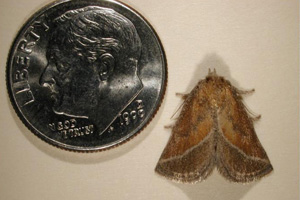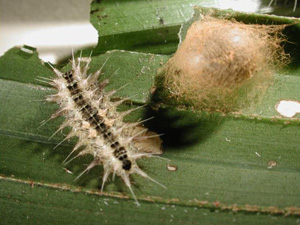Stinging Nettle Caterpillar

Stinging nettle caterpillar
Photo: Brian Bushe, CTAHR
Problem
If something is stinging your arms, legs, or hands when you work in the garden and you end up with a raised, itchy rash you may have stinging nettle caterpillar. Chances are you will not even see the culprit because the caterpillar drops to the ground when you brush against its stinging spines.
Description
The Stinging nettle caterpillar is about an inch in length, has a dark stripe down its back and is covered in very light-colored venomous spines and hairs. When you brush up against the nettle caterpillar, the spines sting, leaving red, inflamed itchy welts. If you look on the underside or on the edges of the leaves of affected plants, you will see them.
Stinging nettle caterpillar attacks many different kinds of grass, palms, dracaena, and ornamental plants. You may see feeding damage on plants; caterpillars chew leaves from the outside edges and work their way in. They may eat entire leaves, leaving only the midribs.
The adult moth is about ½ inch long, brown with white diagonal markings on each wing. The larval stage (caterpillar) is about an inch in length, with stinging spines along the back and sides.

Adult nettle moth
Photo: Brian Bushe and Dr. Arnold H. Hara, CTAHR
Information
A stingless parasitic wasp has been released by the Hawaii Department of Agriculture (June, 2010) in an effort to control the nettle caterpillar. Avoid use of broad spectrum insecticides so that you do not kill the wasp and make your infestation worse.
You can use Bt, Bacillus thuringiensis, which must be eaten by the insect. It is not a contact poison. Bt works by disrupting the stomach enzymes in the host insect and must be reapplied every week until pests have been eradicated. (See article on Bt for more information on how it works.)
You can remove the caterpillars by hand (wear long sleeves, pants and gloves) if the infestation is relatively light. Drop the caterpillars into soapy water.
The adult moth is attracted to light. Try to minimize outdoor lighting at night or use bug zappers with ultra violet bulbs to attract the moths. Put soapy water under the bug zapper to trap moths.

Nettle caterpillar and pupa
Photo: Brian Bushe, CTAHR
Kendal Lyon, Hawaii Island Master Gardeners

